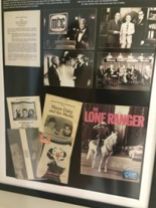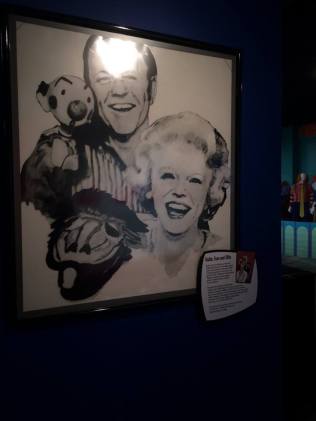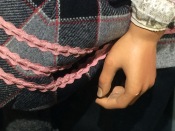
“When I ask him these questions and he answers, I haven’t got the faintest idea what he’s going to say, and what he says astounds me with his wisdom.” –Edgar Bergen
I am a huge fan of old time radio. In fact old time radio shows are the only recordings on my iPod at present! In particular, I’m a fan of The Jack Benny Program, Blondie, The Bob Hope Show, My Favorite Husband, A Date with Judy, Our Miss Brooks (I’m an English teacher!), and of course, The Charlie McCarthy Show. While the other radio shows I mentioned feature a very talented group of radio actors, The Charlie McCarthy Show is especially unique in that we hear Edgar Bergen carrying the show through various personas. Through his aptitude for ventriloquism and excellent comedic timing, Bergen created some of the most beloved characters featured on radio, as well as a host of witty quips and remarks.
Edgar John Bergren was born in Chicago, Illinois, and was one of five children. His parents were Swedish immigrants. They moved to a farm near Decatur, Michigan, and lived there until he was four years old. After that, he and his family returned to Sweden, where he learned the language. When he was eleven years old, he and his family moved to Chicago. It was at this point that Edgar taught himself ventriloquism from a booklet entitled, “The Wizard’s Manual.”

During his teen years, Edgar attended Lake View High School in Chicago. Unfortunately, his father passed away when Edgar was sixteen years old, so Edgar sought work where he could find it. He worked as an apprentice accountant, furnace stoke, player piano operator, and silent-movie house projectionist. Ventriloquist Harry Lester was so impressed by Edgar’s talent and work ethic that he gave a teenaged Edgar lessons in the fundamentals of ventriloquism on an almost daily basis.
When the fall of 1919 approached, Edgar paid Chicago woodcarver, Theodore Mack, $36 to sculpt a model head of a redheaded Irish newspaper boy he knew. That head was eventually situated atop a dummy named Charlie McCarthy, who became Bergen’s sidekick for the rest of his life. Bergen created the body himself, using a nine-inch length of broomstick for the backbone, and rubber bands and cords to control the dummy’s lower jaw.

After graduating from high school, Bergen attended Northwestern University. He enrolled in the pre-med program to please his mother, but wound up switching to a major of speech and drama. He paid for college by performing with Charlie all around Chicago. Bergen decided that show business was his future and he quit school. He gave his first public performance at Waveland Avenue Congregational Church, on the northeast corner of Waveland and Janssen in Chicago. He cut out an “R” and a “G” from his family name and went from Berggren to Bergen on the showbills. Between June 1922 and August 1925, he performed every summer on the professional Chautauqua circuit and at the Lyceum theater in Chicago. Bergen also had an interest in aviation, and became a private pilot.
After working in vaudeville and on one-reel movie shorts, Edgar found that he would be most successful on the radio. He and Charlie were seen at a New York party by Elsa Maxwell for Noël Coward, who recommended them for an engagement at the famous Rainbow Room. It was there that two producers saw Bergen and Charlie perform. They then recommended them for a guest appearance on Rudy Vallée’s program. Their initial appearance (December 17, 1936) was so successful that the following year they were given their own show, as part of The Chase and Sanborn Hour. Under various sponsors (and two different networks), they were on the air from May 9, 1937 to July 1, 1956.

The popularity of a ventriloquist on radio, when one could see neither the dummies nor his skill, surprised and puzzled many critics, then and now. Even knowing that Bergen provided the voice, listeners perceived Charlie as a genuine person, but only through artwork rather than photos could the character be seen as truly lifelike. Thus, in 1947, Sam Berman caricatured Bergen and McCarthy for the network’s glossy promotional book, NBC Parade of Stars: As Heard Over Your Favorite NBC Station.

Bergen also developed other characters for the radio program, most notably, the slow-witted Mortimer Snerd and the man-hungry Effie Klinker. However, Charlie was always the star of the show. He was always presented as a highly precocious child (albeit in top hat, cape, and monocle)—a debonair, girl-crazy, child-about-town. As a child, and a wooden one at that, Charlie could get away with double entendres which were otherwise impossible under broadcast standards of the time.
Charlie and Mae West had this conversation on December 12, 1937.
- Charlie: “Not so loud, Mae, not so loud! All my girlfriends are listening.”
- Mae: “Oh, yeah! You’re all wood and a yard long.”
- Charlie: “Yeah.”
- Mae: “You weren’t so nervous and backward when you came up to see me at my apartment. In fact, you didn’t need any encouragement to kiss me.”
- Charlie: “Did I do that?”
- Mae: “Why, you certainly did. I got marks to prove it. An’ splinters, too.”

Charlie’s feud with W. C. Fields was a regular feature of the show.
- W. C. Fields: “Well, if it isn’t Charlie McCarthy, the woodpecker’s pinup boy!”
- Charlie: “Well, if it isn’t W.C. Fields, the man who keeps Seagram’s in business!”

Since Bergen was not the most technically skilled ventriloquist, Charlie McCarthy would often poke fun at him for moving his lips. However, Bergen had a keen sense of comedic timing. In fact, Bergen’s wit in creating McCarthy’s striking personality and that of his other characters was the making of the show. Bergen’s popularity as a ventriloquist on radio, where the trick of “throwing his voice” was not visible, suggests his appeal was primarily the personalities he applied to his characters.

Dick Powell and Charlie McCarthy
Interestingly, Bergen and McCarthy are sometimes credited with “saving the world” because, on the night of October 30, 1938, when Orson Welles performed his War of the Worlds radio play hoax that panicked many listeners, most of the American public had instead tuned to Bergen and McCarthy on another station and never heard Welles’ play. Conversely, it has also been theorized that Bergen inadvertently contributed to the hysteria. When the musical portion of Bergen’s show, The Chase and Sanborn Hour, aired approximately 12 minutes into the show, many listeners adjusted their dial and found the War of the Worlds presentation already underway with a realistic-sounding reporter detailing terrible events.
Bergen and his alter-ego Charlie McCarthy were given top billing in several films, including the The Goldwyn Follies (1938), opposite the Ritz Brothers. In the following year, they also appeared in You Can’t Cheat an Honest Man with W. C. Fields. At the height of their popularity in 1937, Bergen was presented an Honorary Oscar (in the form of a wooden Oscar statuette) for his creation of Charlie McCarthy. Bergen, along with Charlie McCarthy and Mortimer Snerd were also featured in the 1938 film Letter of Introduction.

In 1941, Bergen met 19-year-old fashion model Frances Westerman in the audience of his radio program as the guest of a member of his staff. The two were married in Mexico after years of long-distance courtship, on June 28, 1945. On May 9, 1946 Frances gave birth to future actress Candice Bergen, whose first performances were on Bergen’s radio show. They also became the parents of film and television editor Kris Bergen, born on October 12, 1961. Frances also became a successful actress, appearing in several movies, co-starring in the 1958 television series Yancy Derringer, and guest-starring in numerous other shows.
In the fall of 1948, Edgar and Charlie faced serious competition from ABC’s “jackpot” quiz show, Stop the Music, which suddenly drew more listeners. By December 1948, Edgar announced he was temporarily “retiring” from radio, admitting that Stop the Music was too popular to compete with. His final NBC broadcast was on December 26, 1948.

In October 1949, Bergen went to CBS, with a new weekly program, The Charlie McCarthy Show, sponsored by Coca-Cola. In October 1954, Kraft Foods sponsored a new Edgar Bergen Hour. After Kraft’s departure, the series continued with participating sponsors as a 55 minute series in the fall of 1955. However, because more people were watching television on Sunday nights than listened to radio (and advertisers preferred to sponsor TV shows by then), the series finally ended on July 1, 1956.

Bergen appeared without Charlie in several films, I Remember Mama(1948), Captain China (1949), The Hanged Man (1964) and Don’t Make Waves(1967). He appeared with Charlie in Look Who’s Laughing (1941) and Here We Go Again (1942), both with Fibber McGee and Molly. Charlie McCarthy can be spotted wearing a US Army uniform in Stage Door Canteen (1943) with Mortimer Snerd. Bergen and McCarthy were also featured in Disney’s Fun and Fancy Free (1947). Although his regular series never made the transition to television, Bergen made numerous appearances on the medium during his career.
Bergen’s craft inspired other puppeteers, such as Jim Henson and Jeff Dunham. In fact, Bergen had a cameo in The Muppet Movie (1979). Bergen died shortly after making the film, his final public appearance, which was subsequently dedicated to him. In September 1978, that he announced that he was retiring after 48 years in show business and sending his beloved partner, Charlie, to the Smithsonian Institution. He opened at Caesar’s Palace Hotel Las Vegas on September 27, for a two week “Farewell to show business” engagement. After struggling with kidney disease, he died in his sleep three days later on September 30, 1978, at age 75.

Today, the iconic wooden Charlie McCarthy rests in Washington D.C.’s Smithsonian Institution. However, the Smithsonian rotates their collection, so there’s a chance you may not see him unless you call ahead to check and see if he’s on display. Despite Charlie being displayed sporadically, according to another blogger, Charlie was most recently displayed at the Smithsonian without his top hat.
When I was looking for information about some locations that would have been relevant to Edgar during his time in Chicago, I found that the 1900 census listed his parents living at 569 N. Francisco. Perhaps this was the home he lived in when he was born. Unfortunately, the home was razed and the property is now part of an industrial area in Chicago.
However, his name first appears in the 1920 census under the name Edgar Bergren, as he had already changed the spelling of his name professionally to Bergen. This lists his home address as 1239 Waveland Ave. He would have resided there when his family returned from Sweden to Chicago. Edgar would have been about 16 years old at that time of the census. The building remains to this day.

Decades after Bergen gave his first public performance at Waveland Avenue Congregational Church, he gave the church a generous contribution, a thoughtful letter, and a photograph of himself which had been requested by the minister and was displayed in the church’s assembly room which was dedicated to Bergen. The church no longer stands today. However, this is the location at present:

While Bergen very publicly donated a Charlie McCarthy puppet to the Smithsonian, many people do not know that there are actually three versions of Charlie McCarthy. One is on display at the Smithsonian Institution, another is at the Museum of Broadcast Communications in Bergen’s hometown of Chicago, and magician David Copperfield owns the remaining dummy.
The Museum of Broadcast Communications is home to a wide variety of radios, sets, and memorabilia. Upon entering, visitors are greeted with the doors to the Oprah Winfrey Show and the set of Family Classics.
Along the hallway, visitors can see a host of old time radios, phonographs, and Victrolas.
The Museum of Broadcast Communications also houses several pieces of memorabilia from the era of old time radio, since Chicago was a major broadcasting city in the heyday of radio. They own the camera used during the Nixon/Kennedy debates, Carol Burnett’s cleaning lady cap, Jimmy Durante’s hat, a Fiber McGee and Molly closet, and a wide range of other items. See what else you recognize!
But, most importantly, the Museum of Broadcast Communications houses a great deal of Charlie McCarthy and Edgar Bergen memorabilia, including fan merchandise, movie posters, awards, lobby cards, toys, and much more.
Additionally, Charlie’s honorary degree from Edgar Bergen’s alma mater, Northwestern University, is also on display there.
Edgar Bergen’s specially-made wooden Oscar and his Emmy are also housed in the Charlie McCarthy display.
Best of all, Charlie McCarthy is on permanent display with his friends, Mortimer Snerd and Effie Klinker. They were donated to the museum by Bergen’s widow upon his passing.

If you’re ever in the Chicago area and want to visit Charlie and his friends, be sure to stop by the Museum of Broadcast Communications at 360 N State Street. While it’s bittersweet to see Charlie spending his lazy days of retirement in silence, I can’t help but think of what he would want to get off his chest today.
August 2019 Update: The Museum of Broadcast Communications has shifted their exhibits around to make room for temporary displays that come through the museum. Upon my last visit, Charlie and the gang were relocated to the ground floor.



















































































Do you know where Edgar worked as a silent movie house projectionist when he was young? I was told it was the Giribaldi Theater on Clark near Belmont in Chicago (later the Clermont Theater) but I can’t find any other source for this.
Pingback: Grauman’s Chinese Theatre Forecourt | Hometowns to Hollywood
Great article, thoroughly researched and well written. I greatly enjoyed Edgar Bergen, Charlie and Mortimer., especially with working with W.C. Fields. I was fortunate to see Charlie at the Smithsonian when he was first on display. Thank you Annette!!
Excellent article – I visited the Smithsonian in ’82 on a school trip and in appropriate section (Archie Bunker’s chair) they had three of the most famous puppets/muppets in history in a glass case: Charlie McCarthy, Kermit T. Frog and Howdy Doodie. One of the displays which truly impressed. Keep up the fabulous work Annette
Pingback: W. C. Fields | Hometowns to Hollywood